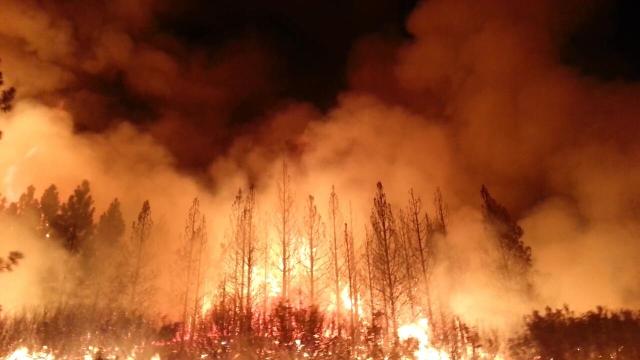Fire is central in the world of black-backed woodpeckers, to the point that the birds pick cavities in recently burned trees to make their nests. But new research suggests that even these fire enthusiasts aren’t able to handle the inferno climate change is already dishing out.
Black-backed woodpeckers (Picoides arcticus) are handsome birds about the size of a robin, with black and white plumage, and a little yellow cap in males. They’re found throughout much of the forested areas of Canada, Alaska, and parts of the far northern and western U.S. After a fire chars a tract of forest, it doesn’t take long for the woodpeckers to move in.
“They eat beetle larvae that live inside of dead wood, so a forest of dead trees is like a plaza of fast food restaurants for a black-backed woodpecker,” Andrew Stillman, an ecologist at the University of Connecticut and lead author on the new study, said.
The birds also prefer to raise their babies in snags — the blackened, skeletal remains of scorched trees — which is metal as hell, and a potential source of conflict with humans, since these burned forests are subject to salvage logging. To figure out what kinds of burned areas should be prioritised for the woodpeckers’ conservation, Stillman and his colleagues collaborated with the Institute for Bird Populations and the U.S. Forest Service to study the birds’ breeding habitat needs.
Over eight years working in the forests of northeastern California, researchers monitored 118 woodpecker nests in six areas recently burned in wildfires, collecting information on what types of habitats the birds were settling in, and how successful their nesting efforts were.
The team found that, as expected, the woodpeckers strongly preferred to nest in “high-severity” patches — places were all or nearly all of the trees had perished in the fire. But surprisingly, the birds targeted the edges of these habitats, often quite close to a stand of living trees. The black-backed woodpecker’s whole thing is roasted timber, yet the birds seem to need less crispy areas, too. Stillman and his colleagues think the living trees provide young birds better protection from predators because they can hang out there while their parents deliver them meals.
“If you’re a fledgling woodpecker, the open and exposed severely burned forests are a dangerous place,” Stillman told Gizmodo. “However, these areas also have the most food. When nests occur near edges, fledglings can stay safe in the live trees while adults forage in dead trees nearby.”
For Quresh Latif, a researcher at the Bird Conservancy of the Rockies, the findings align with some other black-backed woodpecker data he and his colleagues had gathered that suggested burn margins were possibly more useful to the birds than the center of burned patches. At the time, Latif says, the data was surprising, but the new study helps confirm what they were seeing.
Crucially, the findings — published on Wednesday in the journal The Condor: Ornithological Applications — also reveal that the nesting woodpeckers need a variety of habitats following a fire.
This “pyrodiversity” is threatened by the recent rise of mega-fires — massive fires that burn faster, hotter, and with higher flames than what is typical. Mega-fires severely and uniformly torch the landscape, obliterating the border areas that the woodpeckers apparently require. Climate change is predicted to turn on the broiler and make mega-fires the norm. The black-backed woodpecker loves fire, just not that much.
“We might expect that mega-fires could benefit fire-specialists like the black-backed woodpecker,” Stillman said. “However, it seems that the landscapes created by extra large, intense mega-fires are too extreme. Even fire-associated species need variation in habitat and access to both live and dead trees.”
He added that continuing efforts to monitor the woodpeckers and other birds after fires can inform ways to reduce the impact of human activities in these burned areas. For example, delaying salvage logging until after fledging season could make a big difference to the woodpeckers.
“At our study sites in northern California, 95 per cent of nests had fledged by June 29, which may provide a useful benchmark for timing post-fire management that might disturb nesting habitat,” Stillman said.
Latif noted that the information can be used to steer clear of nesting birds as well. “Conservation objectives might be reached by concentrating salvage logging in the core of burned habitats, and avoiding those edges and mosaics,” Latif told Gizmodo.
Whatever the fate of the black-backed woodpecker, its plight is a sobering reminder that in our rapidly warming, changing natural world, it’s possible to be cursed with too much of what appears to be a good thing.
